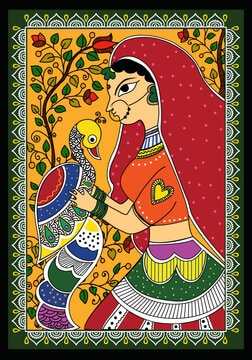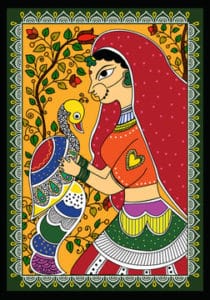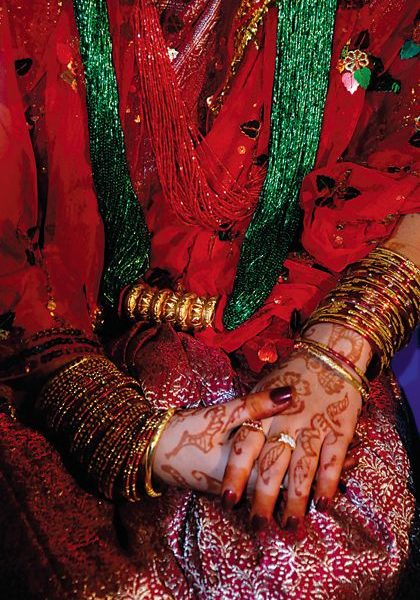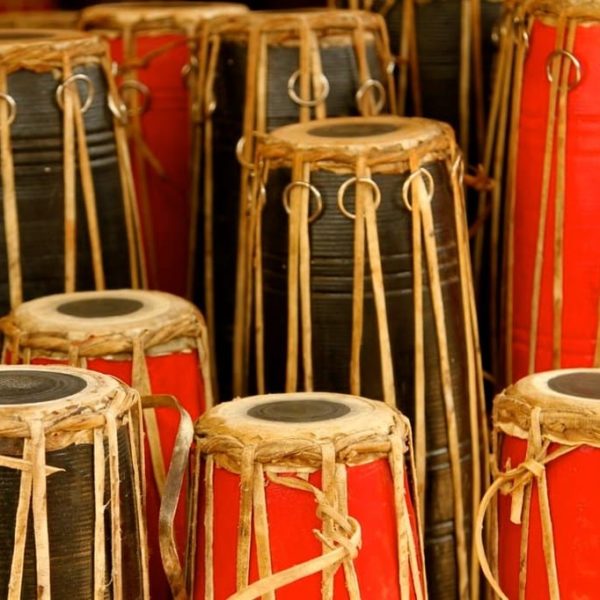INTRODUCTION
Mithila painting, also known as Madhubani art, is a rich and vibrant traditional art form originating from the Mithila region of Nepal and India. This centuries-old practice has been an integral part of the cultural and religious landscape of the Maithili people, who inhabit the southern Terai region of Nepal and the northern part of Bihar in India. Mithila painting has transcended time and geography, remaining an enduring expression of devotion, creativity, and social storytelling.

HISTORICAL ROOTS OF MITHILA PAINTING
The roots of Mithila painting can be traced back to ancient times, with references to it found in Hindu mythology and scriptures. According to legend, the origin of this art form is associated with the marriage of Lord Rama and Sita, who is believed to be from the Mithila region. King Janak, Sita’s father, commissioned artists to decorate the walls and floors of the palace with these paintings to celebrate the auspicious occasion.
Historically, Mithila painting was a household activity performed exclusively by women. The art was passed down from generation to generation, with mothers teaching their daughters how to depict deities, nature, and symbols of life on the walls of their homes. Over time, what started as a domestic ritual evolved into a celebrated art form.
THEMES AND SYMBOLISM
Mithila paintings are deeply rooted in the religious and cultural beliefs of the Maithili people. The primary themes revolve around Hindu gods and goddesses, including deities such as Lord Vishnu, Shiva, Lakshmi, Durga, and Kali. Scenes from epics like the Ramayana and Mahabharata are also popular subjects. Additionally, the paintings often depict nature—trees, birds, animals, and celestial bodies—symbolizing the connection between humans and the environment.
Mithila paintings are also used to mark significant life events, such as births, weddings, and festivals. Each painting carries layers of symbolism. For example, fish represent fertility and prosperity, the lotus symbolizes purity, and peacocks are often depicted as symbols of love and passion.

STYLE AND TECHNIQUE
Mithila painting is distinguished by its use of vibrant colors, intricate patterns, and bold lines. Traditionally, natural dyes and pigments were used, derived from plants, minerals, and other organic materials. For instance, turmeric provided a yellow hue, indigo created blue, and soot was used for black. The art form is known for its use of contrasting colors, flat imagery, and repetitive geometric patterns.
A characteristic feature of Mithila paintings is the lack of empty space. Every inch of the canvas or surface is filled with designs, creating a sense of fullness and richness. This meticulous detailing is what gives Mithila paintings their unique identity. There are two main styles: the bharni (filled) style, which uses vibrant colors, and the katchni (line) style, which is more monochromatic, relying on fine line work.
Mithila paintings are often created on various surfaces, such as walls, cloth, handmade paper, and even cow dung-coated floors. In the modern era, artists have expanded their medium to include canvas and other commercial materials to cater to a growing global audience.

MITHILA PAINTING IN THE MODERN CONTEXT
In the 20th century, Mithila painting gained recognition beyond its regional borders. The 1960s drought in Bihar (which also affected parts of the Mithila region) led to efforts by the Indian government and various NGOs to commercialize the art form, providing local women with an opportunity for economic empowerment. This initiative allowed Mithila artists to present their work to a wider audience, leading to international acclaim.
In Nepal, Mithila painting has not only served as a form of expression but also as a tool for social and cultural preservation. Many women in the Mithila region of Nepal continue to uphold this art form, using it to tell stories of their heritage and beliefs. Moreover, Mithila painting has become a medium for addressing social issues such as gender equality, education, and environmental conservation.
Mithila art is now celebrated globally, with exhibitions held across countries. Artists from the Mithila region have showcased their work internationally, bringing attention to the rich cultural heritage of Nepal. Modern adaptations of this traditional art form can also be seen in fashion, home décor, and even tattoos.
WOMEN AS CUSTODIANS OF MITHILA ART
One of the most remarkable aspects of Mithila painting is that it has historically been dominated by women. This is especially true in Nepal’s Mithila region, where women have been the primary creators and conservers of this art form for centuries. In a traditionally patriarchal society, Mithila painting has provided women with a means of expressing their thoughts, beliefs, and emotions in a visual language.
Today, Mithila painting continues to offer an empowering platform for Nepali women, many of whom have gained financial independence by selling their art. Various organizations and cooperatives have been established to promote this art form and support women artists in the region, ensuring that the craft is passed on to future generations.

CONCLUSION
Mithila painting is much more than an art form; it is a visual representation of the cultural, spiritual, and social life of the Maithili people. From the mud walls of rural homes to the galleries of international exhibitions, this unique form of expression continues to captivate the world with its vibrant colors, intricate designs, and deep-rooted symbolism. In the Mithila region of Nepal, this art remains an enduring testament to tradition, storytelling, and the resilience of women as custodians of culture.
As the world continues to discover and appreciate the beauty of Mithila painting, it serves as a reminder of the importance of preserving traditional art forms that are integral to the cultural identity of a people. Through initiatives supporting artists and promoting this art on the global stage, Mithila painting is likely to flourish for generations to come.






